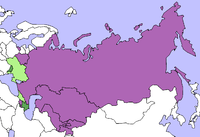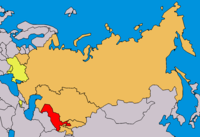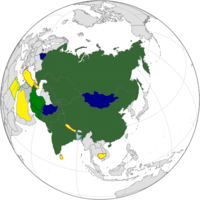Post-Soviet states
From Wikipedia, the free encyclopedia.
The Post-Soviet states, also commonly known as former Soviet republics, are the independent nations which split off from the Union of Soviet Socialist Republics in its breakup in 1991.
Post-Soviet states are subject to various developments in geography, history, politics, economy, and culture in the post-Soviet era, the time after the collapse of the Soviet Union, in the period following Communist Party rule.
Contents |
States and geographical groupings
The post-Soviet states are typically divided into the following five groupings. Each of these regions has its own common set of traits, owing not only to geographic and cultural factors but also to that region's history in relation to Russia.
- Baltic states: Estonia, Lithuania and Latvia.
- The Transcaucasus: Georgia, Armenia and Azerbaijan.
- The Eastern European states of Ukraine, Belarus and Moldova.
- Russia because of its uniquely dominant role in the region is generally treated as a category unto itself.
The Eastern European states had their history intermingled with Russia from its earliest existence as a state, while Central Asia and the Transcaucasus were not conquered by it until the 18th or 19th century. The Baltic countries were ruled by the Teutonic Order, Denmark, Poland and Sweden for significant periods in their history before being incorporated into Imperial Russia in the 18th century and becoming independent nations after World War I. Their annexation by the Soviet Union in 1940 was not recognized by the Western powers.
Economy
Following the collapse of the Soviet Union, the former Soviet republics adopted capitalism as their new economic system. The gross domestic product in all former Soviet republics (excluding the Baltic states) immediately went down, totaling only 86 percent of its 1991 volume. In 1994, inflation reached 400 percent in Ukraine and 1258 percent in Kazakhstan, though comparatively lower in the Baltic states (reaching only 45.1 percent in Lithuania). 1995 was the absolute lowest point of the economic situation in the former Soviet republics. By 2004, only the Baltic States, Armenia, Belarus, and Kazakhstan had reached higher gross domestic products than the ones they had in 1991 as parts of the Soviet Union. In Russia itself, the perceived failure of capitalism to improve lifestyle culminated in the 1998 Russian Economic Crisis, which was followed by a return to more interventionist economic policies by the government.
The reasons for capitalism's apparent failure in the post-Soviet states has been a subject of debate. Poor or limited transportation and communications infrastructure, untested legal systems and weak property rights protection, political instability (except for the Baltic states), and dense bureaucracy are all cited. A key factor is corruption, including poorly managed privatization of state-owned enterprises, which are now controlled by former Soviet apparatchiks or opportunist "oligarchs." Popular opposition to capitalism is also noted, with many of the people who lived their entire lives in communism holding a so-called homo sovieticus mentality. Finally, the free market neoliberalism implemented in most former Soviet republics is called into question and accused of being a flawed economic model.
Regional organizations
A number of international organizations and cooperating blocs have sprung up in the region since the dissolution of the Soviet Union.
The three Baltic states have not sought membership to any of these post-Soviet organizations, seeking and achieving membership in the European Union and NATO instead. Turkmenistan, besides its membership in the CIS, has not sought closer integration in any of the Western or post-Soviet organizations. The other countries have a mixed record of participation.
In this section those organizations are mentioned which are mainly (or completely) composed of post-Soviet states. Organizations with much wider memberships are not discussed.
Commonwealth of Independent States
The Commonwealth of Independent States (CIS) consists of 12 of the 15 former Soviet Republics - the 3 exceptions are the Baltics. It has been said to have been created to "allow a civilized divorce" between the republics, but its members have since signed a number of documents promoting closer cooperation instead.
Six member states (Russia, Belarus, Kazakhstan, Kyrgyzstan, Tajikistan and Armenia) have enhanced their military cooperation, establishing the Collective Security Treaty Organization (CSTO). Five other member states established the GUUAM group that was largely seen as intending to counter Russian dominance in the region. Turkmenistan is the only CIS state that sought membership in neither of these blocs.
Eurasian Economic Community
The Eurasian Economic Community (EURASEC) was established by Russia, Belarus, Kazakhstan, Kyrgyzstan and Tajikistan, having grown out of the CIS Customs Union. Ukraine and Moldova have observer status in the community, however Ukraine has declared its desire not to become a full member state. Because having common borders with the rest of the community is a prerequisite for full membership, Moldova is thus barred from seeking it.
Union of Russia and Belarus
The Union of Russia and Belarus was originally formed on April 2, 1996 under the name "Community of Russia and Belarus", before being tightened further on April 3, 1997. It was initiated by the president of Belarus, Alexander Lukashenko.
On paper, the Union of Russia and Belarus intends further integration, beyond the scope of mere cooperation, including the introduction of the Russian ruble as a common currency.
Shanghai Cooperation Organization
The Shanghai Cooperation Organization (SCO), is composed of China and five post-Soviet states, namely Russia, Kazakhstan, Kyrgyzstan, Tajikistan and Uzbekistan. The organization was founded in 2001, though its predecessor, the Shanghai Five grouping, has existed since 1996. Its aims revolve around security-related issues.
Central Asian Cooperation Organization
The Central Asian Cooperation Organization (CACO) was first initiated by all five Central Asian nations in 1991 as the Central Asian Commonwealth. Later Turkmenistan followed a policy of isolation, withdrawing from participation in all regional forums, while Russia joined the (now renamed) CACO in 2004.
Governments
Regarding political freedom in the former Soviet republics, Freedom House's 2005 report listed the following:
- Estonia, Latvia and Lithuania as "free" countries
- Ukraine, Moldova, Georgia and Armenia were listed as "partly free"
- Russia, Belarus, Azerbaijan and all five Central Asian nations (Uzbekistan, Turkmenistan, Tajikistan, Kyrgyzstan and Kazakhstan) were listed as "not free" -- while Turkmenistan in particular received the worst freedom ratings possible and was listed as one of the eight most repressive regimes in the year.
Similarly, the Worldwide Press Freedom Index published by Reporters Without Borders, recorded the following as regards press freedom:
- A good situation in Estonia, Latvia, and Lithuania
- Noticeable problems in Armenia, Georgia, Moldova and Tajikistan
- A difficult situation in Azerbaijan, Belarus, Kazakhstan, Kyrgyzstan, Russia, Ukraine and Uzbekistan
- A very serious situation in Turkmenistan
It has been remarked that several post-Soviet states have not changed leadership since their independence. Such leaders have been Saparmurat Niyazov in Turkmenistan, Islam Karimov in Uzbekistan, and Nursultan Nazarbayev in Kazakhstan. All of these had originally more limited terms but through decrees or referenda prolonged their stay in office (a practice also followed by President Alexander Lukashenko of Belarus). Askar Akayev of Kyrgyzstan had likewise served as President since its independence until he was forced to resign as a result of the Kyrgyz revolution of 2005.
The issue of dynastical succession has been another element affecting the politics of some post-Soviet States, with Ilham Aliyev following up on the presidency of his father (Heydar Aliyev) in Azerbaijan, and theories about the children of other leaders in Central Asia also being groomed for succession. [1] The participation of Akayev's son and daughter in the 2005 Kyrgyz parliamentary elections boosted fears of dynastic succession being used in Kyrgyzstan as well, and may have contributed to the anti-Akayev climate that led to his overthrow.
Wars and conflicts
Separatist conflicts
Most military conflicts in the post-Soviet space have had to do with the separatist desires of territories with different ethnic or religious demographics than the majority of the state they're officially recognized as part of.
Such territories and resulting military conflicts have so far been:
- Transnistria, seeking independence from Moldova
- Abkhazia, South Ossetia and Ajaria, seeking independence from Georgia.
- Chechnya and Dagestan, seeking independence from Russia.
- Nagorno-Karabakh, seeking independence from Azerbaijan.
Out of these regions, Ajaria has been fully reincorporated into Georgia and the conflict there has ended peacefully. Separatist leader Aslan Abashidze fled to Russia where he was granted asylum.
After two bloody wars Chechnya is under the control of the central Russian government, but the conflict there has not yet ended.
Transnistria, Abkhazia and South Ossetia on the other hand, have achieved de facto independence which is however unrecognized by any other country in the world — a Russian military presence exists in all three of these territories. Nagorno-Karabakh has likewise achieved a de facto independence, with Armenian troops having control of all the territory and even of neighboring parts of Azerbaijan. Since 1994 these four regions have made an agreement of mutual assistance, and their leaders have in several occasions reiterated such pledges. [2][3] [4]
Other civil wars
Civil wars unrelated to separatist regions have occurred twice in the region:
- The Georgian Civil War between the forces of Zviad Gamsakhurdia and Eduard Shevardnadze. The war ended after Russian forces intervened in support of Shevardnadze's government, which in turn agreed to join the Commonwealth of Independent States.
- The Tajikistan Civil War that lasted between 1992 and 1997.
Color revolutions
Lastly, since 2003, a number of (largely) peaceful "color revolutions" have happened in three post-Soviet states after disputed elections, with popular protests bringing into power the former opposition.
- The Rose Revolution in Georgia, leading to the fall from office of Eduard Shevardnadze.
- The Orange Revolution in Ukraine, bringing into power Viktor Yushchenko.
- The Tulip Revolution in Kyrgyzstan, leading to the resignation of Askar Akayev.
See also
| Regions of the World | |
| Africa: | Central Africa | East Africa | Great Lakes | Guinea | Horn of Africa | North Africa | Maghreb / Northwest Africa | Sahel | Southern Africa | Sub-Saharan Africa | Sudan | West Africa |
| Americas: | Andean states | Caribbean | Central America | Great Lakes | Great Plains | Guianas | Latin America | North America | Patagonia | South America | Southern Cone |
| Asia: | Central Asia | East Asia | East Indies | Far East | Indian subcontinent | North Asia | Southeast Asia | Southwest Asia (Middle East / Near East, Levant, Anatolia, Arabia) |
| Europe: | Balkans | Baltic region | Benelux | British Isles | Central Europe | Eastern Europe | Northern Europe | Scandinavia | Southern Europe | Western Europe |
| Eurasia: | Caucasus | Mediterranean | Post-Soviet states |
| Oceania: | Australasia | Melanesia | Micronesia | Polynesia | Aleutian Islands | Pacific Rim |
| Polar: | Arctic | Antarctic |








